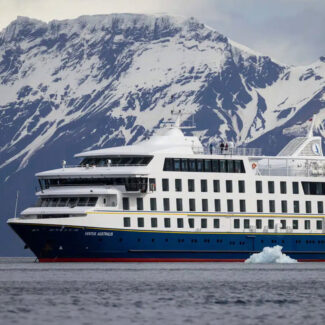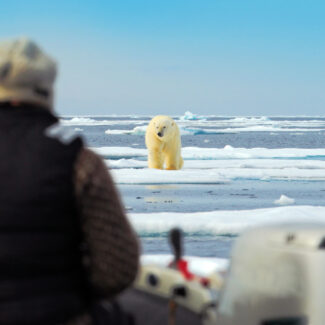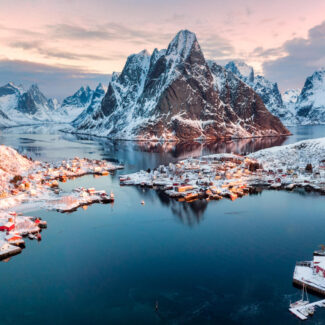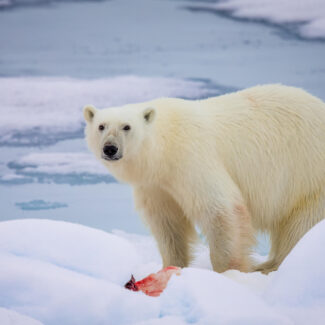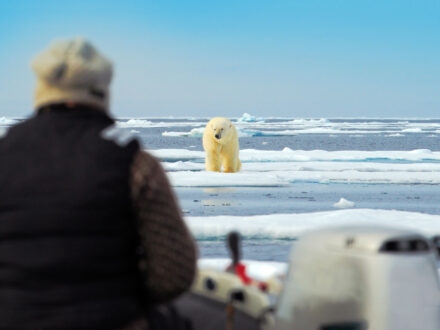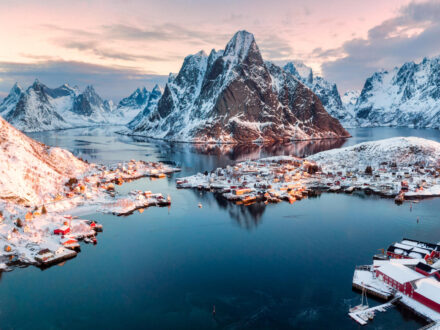Can You Go To Antarctica? Yes! Here's How To Visit
- Can I Go To Antarctica At My Age?
- Do You Need Permission To Go To Antarctica?
- How Do You Get To Antarctica?
- How To Go To Antarctica: Tour Options
- How To Get To The South Pole
- How To Visit Antarctica—Responsibly
- How To Book A Trip To Antarctica
- Antarctica’s White Wilderness Awaits You
The fact that Antarctica is so remote and so pristine leads many people to assume this greatest terrestrial wilderness left on Earth is off-limits to tourism. So, can you travel to Antarctica?
Absolutely! Indeed, the White Continent grows more popular as a sightseeing and adventure destination every year, at the latest count some 73,000 annual visitors sailing Antarctica’s waters aboard 60 or more expedition vessels. Sure, it takes a fair amount of planning and preparation, but you’d be amazed how accessible the Antarctic—portions of it, anyway—actually are.
In this article, we’ll run through the basics of getting to Antarctica, typical kinds of tours, and some of the considerations for being an environmentally responsible visitor here: of paramount importance for preserving this incredible, globally precious realm. But before we look at logistics and etiquette for your expedition, let’s address a couple of questions that are often asked by prospective visitors to Antarctica.
Can I Go To Antarctica At My Age?
Whilst the International Association of Antarctic Tour Operators (IAATO) advise a minimum age limit of 5 years, this is not binding, so you will find that many Antarctica tour operators enforce their own age restrictions, with many typically having a minimum age policy of 12 years old, although this can sometimes be as low as 8 years old. There is currently no upper age limit for visiting Antarctica. Indeed, Antarctica attracts visitors of all ages, and on most Antarctica cruises you will find a number of septuagenarians, and even the odd octogenarian.
The choice to visit Antarctica very much comes down to your own health and physical fitness levels. Just bear in mind that typically there are a couple of shore landings per day which may involve hikes on slippy, uneven terrain, and wet Zodiac landings whereby you disembark into shallow water. There is no need to participate in more strenuous pursuits such as kayaking, skiing and mountaineering as these are normally optional add-on activities.
The only real requirement is that you are able to get in and out of the smaller Zodiac boats which are used for excursions. You will also be asked to fill out a medical questionnaire shortly after booking which will be reviewed by your ship’s doctor, but this is usually just to check if you have any medical conditions that may prevent you from participating in certain activities rather than not allowing you to go. For example, having a pacemaker would mean you wouldn’t be allowed to do the polar plunge.
Yes, you can go to Antarctica! There’s no upper age limit for visiting this incredible continent, as long as you’re in good health and have a sense of adventure. Imagine experiencing breathtaking moments like this, gazing upon colossal ice formations from the comfort of your cruise ship, regardless of your age.
Do You Need Permission To Go To Antarctica?
Citizens of many countries do indeed need permission to travel to Antarctica. Specifically, travelers living in countries that are party to the 1959 Antarctic Treaty—which originally included a dozen signatories and now counts 56—must have a permit. That was established in the early 1990s with the adoption of the Protocol on Environmental Protection to the Antarctic Treaty. This includes those coming to Antarctica from, for example, the United States, Canada, the U.K., China, Australia, and Germany.
This needn’t be complicated, however. In nearly all cases, your permit is taken care of by the tour operator you’re going through. So it’s basically a non-issue, unless you’re undertaking an independent expedition to Antarctica—not an especially common route, needless to say. (Can you go to Antarctica without permission? Technically, you might be able to if you reside in one of the non-signatory countries, but probably only if you get yourself to the White Continent: If you’re signing on to a cruise or flight operated out of a signatory nation, you likely will need a permit regardless of your citizenship.)
You will need a valid passport to travel to Antarctica, but because Antarctica belongs to no country you don’t need a visa to travel there per se, however any country you do pass through to get to Antarctica (such as Argentina, Chile, Australia or New Zealand) may require a visa depending on your country of origin.
How Do You Get To Antarctica?
Far and away the most popular jumping-off point for Antarctica is Ushuaia, Argentina, set down in Tierra del Fuego: the southernmost reach of mainland South America, and therefore just a stone’s throw—relatively speaking—to the Antarctic realm. From this port—readily reached by direct flight from Buenos Aires, and fascinating in and of itself—cruises head for the Drake Passage, the fabled oceanic frontier between South America’s Cape Horn and Antarctica. This usually takes anywhere from a day and a half to three days to cross. The notoriously rough Drake Passage is its own attraction, thanks to its wild ambience and its rich array of birdlife and marine mammals.
That said, some tourists who are (a) strapped for time and/or (b) prone to seasickness prefer to skip the voyage across the Drake Passage and embark from Punta Arenas, Chile, flying directly to King George Island in the South Shetland Islands in just 2 hours rather than 2 days at sea. From there, these “fly-cruise” customers can then join ships touring the Antarctic Peninsula, the ultimate destination for passengers sailing out of Ushuaia. It’s worth noting that this option does limit your choice of ships, itinerary and departures dates somewhat, and often proves more expensive.
Such itineraries (depending on whether you skip the Drake Passage or not) often run a week to a week-and-a-half or so. But many travelers who can afford to do so opt for longer expeditions—sometimes up to three weeks in duration—allowing them to spend more time exploring the sub-Antarctic islands, such as the Falklands and South Georgia, which serve up as extraordinary a wildlife smorgasbord as the Antarctic Peninsula—plus their own remote, windswept Southern Ocean splendor.
Your incredible journey to Antarctica typically begins in a vibrant gateway city like Ushuaia, Argentina, the “End of the World.” From here, you’ll embark on your expedition vessel, sailing through the iconic Drake Passage to reach the White Continent.
South America ports—foremost Ushuaia (cruises), then Punta Arenas (fly-cruises)—serve as the primary launchpad for Antarctic trips, with some 98% of visitors approaching Antarctica from its nearest continental neighbor. But it’s also definitely possible to journey to the White Continent from Oceania, via such jump-offs as Invercargill or Dunedin, New Zealand and the Tasmanian capital of Hobart, Australia. Predominantly aimed at the Ross Sea and such East Antarctica locales as Commonwealth Bay, these trips tend to involve longer Southern Ocean passages on the order of a week or thereabouts, with a total duration commonly around a month or so. Such sub-Antarctic islands in between as Australia’s Macquarie and New Zealand’s Campbell and Auckland archipelagos are often included in these sails.
Most Antarctica cruise itineraries are round-trip in nature, embarking and disembarking from the same port, but there are some notable exceptions. Fly-cruise goers who want to save time and still cross the Drake Passage may choose to fly out from Punta Arenas and sail back to Ushuaia (or vice versa). Once a season there may also be rare “repositioning” cruises beginning in Punta Arenas, Buenos Aires or Puerto Madryn (Argentina) which will end in Ushuaia, and the odd trans-oceanic itinerary starting in Ushuaia and ending in Cape Town (South Africa).
In addition to the above ports, a number of Southern Hemisphere cities serve as departures for flights to or over Antarctica, including Punta Arenas (Chile), Sydney (Australia) and Cape Town (South Africa), amongst others.
How To Get To Antarctica From Your Country
The two aforementioned port cities of Ushuaia (Argentina) and Punta Arenas (Chile) where the majority of cruises leave from unfortunately don’t have international airports, so to get to them you’ll most likely have to fly via Buenos Aires (Argentina), or Santiago (Chile) respectively.
Whilst the international airport in Santiago—Arturo Merino Benitez (SCL)—is also used for the domestic flights to Punta Arenas making connections simple, if you fly via Buenos Aires note that the flights to Ushuaia are from the domestic airport Jorge Newbery Airfield (AEP), so a transfer is required from the city’s Ezeiza International Airport (EZE). Given at least four hours should be left between flights for this transfer and subsequent check in, many travelers to Antarctica choose to include a stopover in Buenos Aires as part of their plans.
How to get to Antarctica from the USA
Getting to Ushuaia via Buenos Aires: Daily direct flights to Buenos Aires operate from Miami, Houston, Atlanta, Dallas and New York (approx. 9-10 hours). Once in Buenos Aires, there are regular flights to Ushuaia (approx. 4 hours).
Getting to Punta Arenas via Santiago: There are daily, direct flights to Santiago from Miami, Houston, Atlanta, Dallas, New York and Los Angeles (approx. 8-10 hours). Once in Santiago, there are regular flights to Punta Arenas (approx. 3.5 hrs).
While your Antarctic adventure itself is often about remote wilderness, getting there can offer its own unique charm. Depending on your country of origin, you might begin your journey in vibrant cities like Punta Arenas, Chile, before connecting to your expedition, making the travel itself part of the grand exploration.
How to get to Antarctica from Canada
Getting to Ushuaia via Buenos Aires: There are daily indirect flights to Buenos Aires from Toronto and Montreal via Bogota, Miami, Panama City or Punta Cana, with extra routes via Lima or Havana also available from Toronto (all approx. 13 hours). Once in Buenos Aires there are regular flights to Ushuaia (approx. 4 hours).
Getting to Punta Arenas via Santiago: There are direct flights from Toronto to Santiago 5 times a week (approx. 10 hours). Once in Santiago there are regular flights to Punta Arenas (approx. 3.5 hours).
How to get to Antarctica from the UK & Europe
Getting to Ushuaia via Buenos Aires: There are direct flights to Buenos Aires daily from Amsterdam, Paris, Frankfurt, Madrid, Barcelona and Rome, and 5 times a week from London (approx. 14 hours). Once there, there are regular flights to Ushuaia (approx. 4 hours).
Getting to Punta Arenas via Santiago: There are direct flights to Santiago daily from Paris and Madrid, and 4 times a week from London and Barcelona (approx. 14 hours). Once there, there are regular flights to Punta Arenas (approx. 3.5 hours).
How to get to Antarctica from Australia & New Zealand
Getting to Punta Arenas via Santiago: There are direct flights to Santiago from Auckland daily (approx. 11 hours) and from Sydney 4 times a week (approx. 12 hours). Once there, there are regular flights to Punta Arenas (approx. 3.5 hours).
Getting to Ushuaia via Buenos Aires: As there are no direct flights from Australia or New Zealand to Buenos Aires, travelers must first fly to Santiago (as above) from where there are regular flights to Buenos Aires (approx. 2 hours). Once in Buenos Aires there, there are regular flights to Ushuaia (approx. 4 hours).
Getting to Antarctica directly: Alternatively, you may avoid going via South America altogether. You might choose to cruise directly from Oceania, as a handful of cruises depart each season from Hobart in Tasmania (approx. 7 days to reach Antarctica), or Invercargill or Dunedin, New Zealand (approx. 5 days to reach Antarctica). There are flights to Hobart from Melbourne, Sydney, Brisbane, Perth and Adelaide in Australia, and flights to Invercargill and Dunedin from Auckland, Wellington and Christchurch in New Zealand respectively. Alternatively, for those that are content with only seeing Antarctica from above for a few hours, there are also infrequent round-trip flight options from Adelaide, Brisbane, Canberra, Sydney, Hobart, Melbourne and Perth in Australia allowing you to see Antarctica in a day (approx. 3-4 hours to reach Antarctica).
How to get to Antarctica from South Africa
Getting to Ushuaia via Buenos Aires: You could fly from Cape Town or Johannesburg to Luanda, Angola (approx. 4 hours) and on to São Paulo, Brazil (approx. 8 hours) before flying on to Buenos Aires (approx. 3 hours). Once there, there are regular flights to Ushuaia (approx. 4 hours).
Getting to Punta Arenas via Santiago: There are no direct flights from South Africa to South America. You could fly to Santiago from Cape Town or Johannesburg via Atlanta, Paris, London or even Sydney (approx. 24 hours). Once there, there are regular flights to Punta Arenas (approx. 3.5 hours).
Getting to Antarctica directly: In the past, Antarctic research ships have embarked upon expeditions from both Cape Town and Port Elizabeth, but currently there are no regular Antarctic cruises scheduled to depart from South Africa. However—if you have the money—you may avoid going via South America and consider flying direct to Antarctica from Cape Town (approx. 5 hours to reach Antarctica) by exclusive private jet. In contrast to the Australia day-trip flights which only allow you to see Antarctica from above, from South Africa you get to experience the real interior of Antarctica in a single day and actually land at Wolf’s Fang Runway, spending a few hours hiking, biking and picnicking on the ice before your return flight. There are also longer fly-in itineraries of 4-8 day’s duration staying at luxury camps on the White Continent.
Please note that although no Antarctic cruises currently depart from South Africa, several cruise companies do offer trans-oceanic itineraries from Ushuaia to Cape Town via Antarctica.
Navigating stunning passages like the Lemaire Channel is a highlight of any Antarctic cruise! The calm, reflective waters mirror the majestic, snow-capped peaks, creating an unforgettable vista that showcases the incredible beauty and accessibility of the White Continent.
How To Go To Antarctica: Tour Options
Both large cruise ships and smaller, expedition-style vessels ply Antarctic waters. The big cruise ships provide more onboard luxuries and comforts, but less flexibility and reach; due to both environmental and logistical limitations, the biggest don’t offer landfalling options, functioning purely as “cruise-by” sightseeing. You’ll also, unsurprisingly, be rubbing shoulders with more people, as these vessels may carry more than 1,000 passengers.
Smaller expedition cruises are the preeminent choice for those with time enough to experience Antarctica by water. Indeed, many seasoned visitors contend this is the best way to see Antarctica, all else being equal. These ice-worthy ships commonly ferry under 100 passengers, and no more than a couple hundred, along the Antarctic Peninsula, and interweave thrilling landfalls and small-group Zodiac cruises as part of the daily itinerary.
Expect onboard naturalists and other guides regardless of whether you’re riding a massive cruise ship or an expedition craft.
Besides the fly-cruise itineraries that combine flights to the vicinity of the Antarctic Peninsula with shipboard sightseeing, there are various plane-only experiences available on the White Continent. These include time-efficient fly-overs that serve up a bird’s-eye of this spectacular wilderness without ever touching down, plus the more exclusive (and expensive) fly-in trips actually landing you in the little-visited Antarctic interior.
How To Get To The South Pole
A very few people, relatively speaking, make that aforementioned odyssey into the heart of the White Continent. But it is possible, if you have the financial resources and requisite thirst for adventure. Fly-in trips can involve skiing, mountaineering (the Vinson Massif, Antarctica’s 16,050-foot rooftop, is a coveted goal for adventurers, particularly those looking to notch off all of the Seven Summits), and setting foot, one way or another, on the near-mythic South Pole.
Compared to the usual explorations of the Antarctic Peninsula, travels into the Antarctic interior don’t serve up much in the way of wildlife: The chief attraction is the raw scenery and the utter back-of-beyond remoteness. However, such fly-in trips are a good option for those eager to see emperor penguins in their farflung haunts; this biggest of penguin species, the only kind to overwinter in the heart of Antarctica, is only fleetingly seen on typical cruises along the Peninsula.
While a visit to the geographic South Pole itself is a highly specialized expedition, a cruise to the Antarctic Peninsula offers an incredible journey to the continent, bringing you face-to-face with its iconic wildlife, like these charming penguins, and breathtaking icy landscapes. It’s an accessible way to experience the magic of the polar south.
How To Visit Antarctica—Responsibly
So—you are indeed able to visit Antarctica, no question, armed naturally with the requisite permit. But the chance to see this dreamscape—its fluted icebergs, looming ice-shelves, seal colonies, penguin towns, ice-armored summits, whale-plowed leads and bays—comes with some heady responsibility. That’s only as it should be, given the White Continent is the last great subaerial wilderness on Earth. Everybody coming here—researchers, tour operators, guides, and tourists—must do their part to minimize impacts on the landscape and seascape and their ecosystems.
Choosing an Antarctic experience via an International Association of Antarctic Tour Operators (IAATO) outfit is fundamental to responsible ecotourism. The IAATO maintains an excellent collection of online resources focused on visitor guidelines for Antarctica, well worth checking out even if you’re only in the early stages of considering such a trip.
How To Book A Trip To Antarctica
Now you know that you can go to Antarctica, how to get there from your home country, and your options on how to visit, all that’s left to do is to book your trip to Antarctica (and any requisite insurance). Booking an Antarctica cruise can set you back anywhere between USD$6,000 and USD$50,000—a not insignificant amount—so you’ll want to know you are in safe hands, are getting the best value for your money that you can, and are going to get the experience you think you are paying for (not all ships allow you to set foot on the continent for example).
Booking a trip to Antarctica via a trusted travel agency with expertise in expedition cruising gives you access to a wider array of cruise options, more impartial advice, and greater visibility of the trips and deals available across the market than if you go directly through an operator. This often means you’ll pay less for your desired experience and provides the kind of peace of mind that can only be gained by talking with experts.
Antarctica’s White Wilderness Awaits You
How hard is it to go to Antarctica? Not all that hard, in fact—not in this day and age. Considering the extreme isolation and overall inhospitality of the White Continent—and remembering the epic trials and travails early explorers endured to even get close to its icy margins—it’s remarkably straightforward to see this place.
A well-chosen tour operator will take care of all the nitty-gritty details, and you can focus on the once-in-a-lifetime experience: whales spyhopping amid ice floes, penguins porpoising through the water, the delicious remoteness of polar peaks and soaring ice battlements, and all the rest of the singular magic at play down here at the bottom of the world!
Disclaimer
Our travel guides are for informational purposes only. While we aim to provide accurate and up-to-date information, Antarctica Cruises makes no representations as to the accuracy or completeness of any information in our guides or found by following any link on this site.
Antarctica Cruises cannot and will not accept responsibility for any omissions or inaccuracies, or for any consequences arising therefrom, including any losses, injuries, or damages resulting from the display or use of this information.




